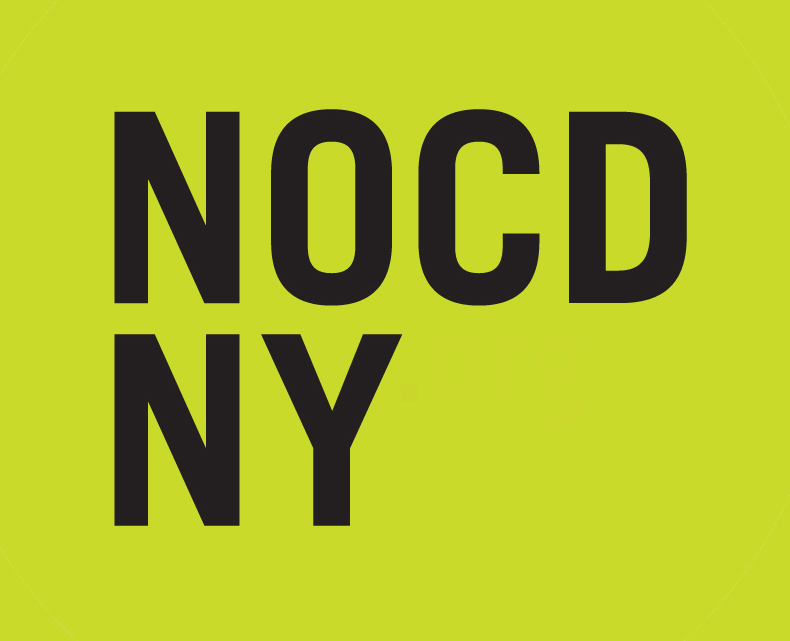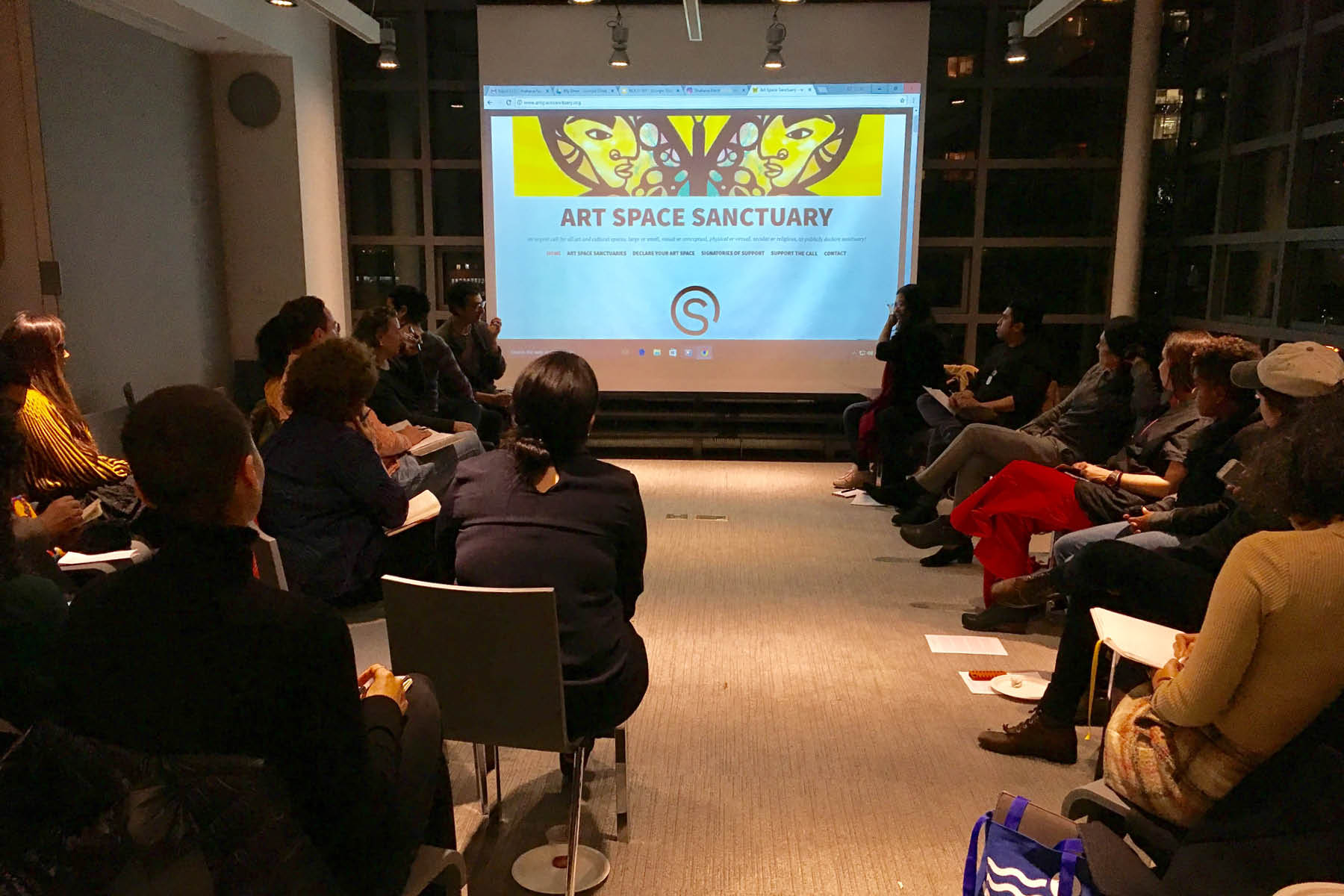Immigration
photo: Tom Oesau
by Addison Vawters
Fourth Arts Block (FABnyc)
On November 8th, 2017, the NOCD-NY network and partners kick started a series of thematic peer learning exchanges. The focus of the evening was the role of artists and cultural organizations in helping to address the challenging conditions that immigrant communities face in today’s hostile political climate.
The evening’s presenters included Abou Farman (Art Space Sanctuary), Shahana Hanif (Bangladeshi Community Liaison in Kensington, Brooklyn for Council Member Brad Lander), and Milton X Trujillo (filmmaker and community council member for Immigration Movement International based in Corona, Queens). Many, if not most, of the evening’s participants were first or second generation immigrants and found that they shared similar concerns around how to work in service of their communities, how to create spaces for immigrants, how to navigate complicated legal and cultural issues, how to include youth in this important work, how to create sanctuary, and how to make their work visible, in a way that grows participation and impact.
Sanctuary
Art Space Sanctuary is a group of artists and activists calling upon cultural organizations to create sanctuary through a variety of tested and meaningful practices. Abou Farman, a founding member, describes that each month about 16,000 people are removed from their communities in the US, most of whom are from the Caribbean, Mexico, Central America and South America. ICE reported 20,000 deportations a month for 2016. Farman describes U.S. Immigration and Customs Enforcement (ICE) as a rogue paramilitary force whose actions are by nature unconstitutional. In ICE's pursuit to meet a Congressionally mandated bed quota for the Department of Homeland Security, people are often detained without a warrant for unreasonable periods of time with no due process. Farman’s example illustrates how the issues complicating the US Immigration system overlap with a wider set of racialized injustices perpetrated by U.S. prison policy.
Participants shared the perspective that while many of today’s efforts on immigration reform, prison reform, and prison abolition began decades ago, the growing prominence of nationalist sentiment in the US and abroad, encouraged by an administration that advertises an overt disregard for human rights, is fomenting an atmosphere of fear in communities of immigrants.
We can dispel this sense of fear through community organizing. The concept of sanctuary can be broadly defined. Farman punctuates that artists and cultural institutions have the ability to create sanctuary rather easily by understanding your right to deny ICE access to your space without a warrant, using your body as a legal barrier, through your ability to use your space and your practice to amplify this information within a network of allies, and by inviting threatened community members into this network. Supporting Immigrant-Driven Work
El Puente is a Williamsburg and Bushwick, Brooklyn based organization that has worked for decades to reduce gang violence and improve public health by bridging arts, education, and activism. El Puente developed a model of youth and community development that emphasizes the importance of youth agency by creating opportunities for young community members to grow into leadership positions. Many of El Puente’s staff first walked through the organization’s doors as youth. Today, young DACA recipients organize other immigrant youth. Asenhat Gomez, a program director, emphasized two points that would echo throughout the evening. First, immigrants, who are closest to the issue, have been and must lead this work. Second, people should ask themselves if they are prepared to alter the ways in which they work permanently. Temporary projects calling awareness to the plight of undocumented immigrants are insufficient. Work has to lead to the creation of and strengthening of community infrastructure that supports the security and livelihood of immigrant individuals, families, and communities. Masoom Moitra, an urban planner, activist, artist, and educator at the New School, concurs that there are untapped opportunities for reverse education where immigrant community leaders would be able to train or pass their knowledge on to new organizers or practitioners from diverse fields.
The Immigrant Movement International (IMI) Community Council exemplifies how to center grassroots voices in cultural work. Milton X Trujillo, a filmmaker, describes IMI as an open education and art space made possible by funding from the Queens Museum. Community members gather in the Corona, Queens storefront space to make art and access education and legal services. As the project grew, an intergenerational community council was created to guide the production of community art and make decisions on the use of the space. They employ a popular education and a democratic approach where everyone has a stake in decision making and curriculum. The youngest member of the council is 9 years old. Meetings are led using a language justice framework, making it possible for people to speak the language they are most comfortable with. Milton remarks on the importance of language justice in both cultural production and community organizing, sharing how much it means personally to create art in an environment where people are speaking in Milton's same accent.
As a resident of the Bangladeshi community in Kensington, Shahana Hanif seconded the necessity for the decolonization of language in immigrant organizing and cultural work. While DACA and sanctuary are pressing issues, Hanif has learned in her role as Community Liaison for Council Member Brad Lander's Office that immigration and citizenship needs are not always exactly what you might imagine. Priorities include free phone service for single and older women, a women’s center that features programming and services chosen by and for women, HRA benefits (particularly SNAP and cash assistance), affordable apartments, and fresh and affordable produce.
Juan Carlos Ruiz, a minister and co-founder of New Sanctuary Coalition affirmed that immigration issues are transracial and emphasized the importance of intergroup solidarity. Immigrants are facing human rights violations each day in New York City and internationally. He asks, “If we’re not seriously considering what our role is in addressing this, then isn’t our own humanity at stake?”
Additional resources:
National Immigrant Justice Center information on detention bed quotas: https://www.immigrantjustice.org/eliminate-detention-bed-quota
Immigration Movement International (IMI) window projects: https://vimeo.com/179053695

